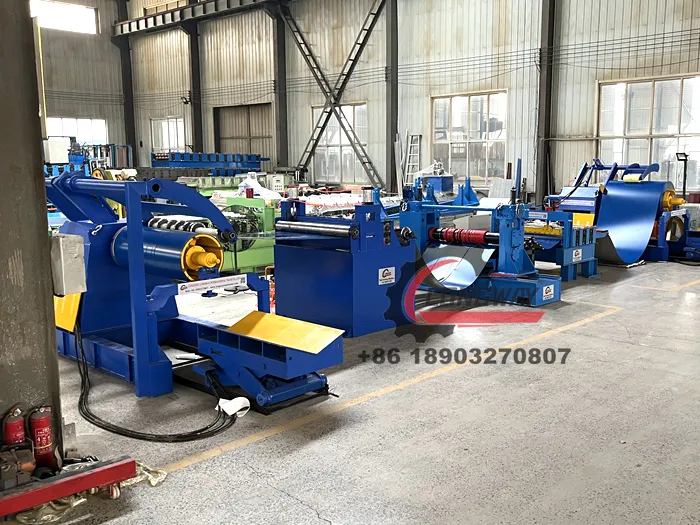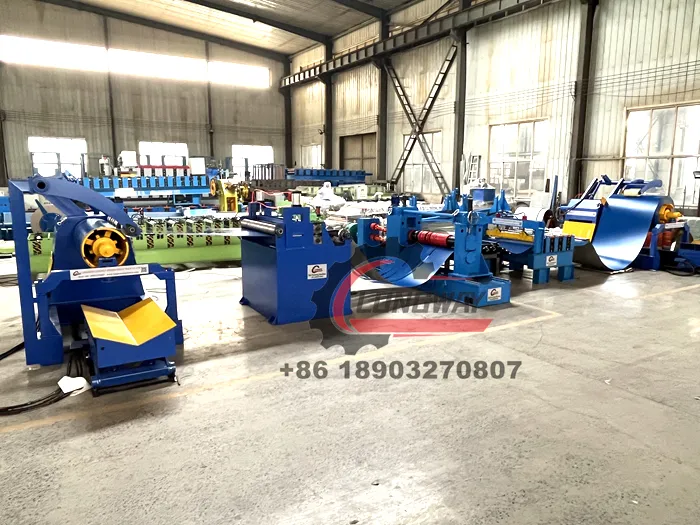How Slitting Lines Improve Efficiency and Precision in Steel Production
Steel production is a complex and demanding process that requires precision, efficiency, and consistency. As industries worldwide rely on steel for a variety of applications—from construction to automotive manufacturing—the need for high-quality, accurately cut steel sheets has never been greater. Slitting lines have emerged as a key technology in modern steel production, helping to improve both the efficiency and precision of metal processing. This article explores how slitting lines contribute to the steel industry’s ability to meet growing demands while maintaining high standards of quality.

The Function of Slitting Lines in Steel Production
Steel slitting line are specialized machines used to cut large coils of steel into narrower strips, also known as slit coils. The process begins by uncoiling a large roll of steel, which is then fed through a series of rollers and cutting blades that slice the metal into precise widths. The slit coils are then rewound into smaller rolls, ready for further processing or distribution.
In steel production, where consistency and precision are paramount, metal slitting line provide an automated solution to ensure that cuts are made to exact specifications. This is especially important in industries like automotive manufacturing, where the exact width of the steel sheets is crucial for the production of various components such as body panels and chassis parts.
Enhanced Speed and Efficiency With Slitting Lines
One of the most significant advantages of slitting lines is the speed and efficiency they bring to the production process. In traditional steel processing, manually cutting coils or using slower, less precise methods can be time-consuming and prone to errors. Slitting lines, on the other hand, automate the cutting process, which not only speeds up production but also ensures that the cuts are consistent and precise.
The automation of the slitting process allows steel manufacturers to achieve higher throughput, reducing the time spent on each coil and increasing overall productivity. With the ability to handle large volumes of steel in a relatively short amount of time, slitting lines help manufacturers meet tight production deadlines and demand from industries that rely on fast and efficient metal processing, such as automotive and construction.
Precision in Steel Cutting About Slitting Lines
Precision is a critical factor in steel production. Even small variations in the width of cut steel strips can lead to defects or inefficiencies downstream in the manufacturing process. Slitting lines address this challenge by providing highly accurate cuts with minimal tolerance. The advanced technology in modern slitting lines ensures that each cut is made to the exact specifications required, reducing the risk of errors and scrap material.
The precision of slitting lines is largely due to their advanced control systems and automated adjustments. For instance, modern slitting lines feature digital controls that allow operators to adjust cutting parameters, such as blade speed and tension, in real-time. This ensures that the machine adapts to the material being processed, taking into account variations in thickness, surface quality, and other factors that might otherwise affect the cutting process.
By ensuring accurate cuts, slitting lines also help steel manufacturers maintain high-quality standards for their products. The ability to produce steel strips with consistent dimensions and minimal defects is essential for industries that require high-quality steel, such as the automotive and aerospace sectors.

Material Optimization and Waste Reduction About Slitting Lines
In steel production, the efficient use of materials is vital, especially as the cost of raw steel can be significant. Slitting lines help to optimize material usage by minimizing waste during the cutting process. With precise cutting capabilities, slitting lines ensure that each coil is used as efficiently as possible, reducing the amount of scrap generated.
Additionally, slitting lines often come equipped with advanced technologies that allow for real-time monitoring of material quality. For example, many slitting lines feature automatic scrap detection and rejection systems that identify and remove defective sections of steel before they are processed. This reduces the likelihood of scrap material entering the production flow and helps to maximize the usable material from each coil.
The reduction of waste also has environmental benefits. By improving material efficiency and reducing scrap, slitting lines contribute to the sustainability of steel production, making it a more resource-conscious process. This is increasingly important as industries face pressure to adopt more sustainable manufacturing practices and reduce their environmental impact.
Flexibility and Customization About Slitting Lines
Slitting lines are highly flexible and can be customized to handle various steel grades, thicknesses, and coil sizes. This versatility allows steel manufacturers to cater to a wide range of customer needs. Whether the requirement is for thin, precision steel strips used in electronics or thicker strips for use in construction materials, slitting lines can be adjusted to meet these diverse needs.
Moreover, slitting lines can be equipped with multiple slitting heads, allowing them to process several strips simultaneously. This makes it possible to produce different sizes of steel strips in one cycle, further improving efficiency and adaptability. Such flexibility is particularly valuable for industries with varying production requirements or those that need to produce custom-sized steel strips for specific applications.
Technological Advancements in Slitting Lines
Technological innovations have significantly enhanced the capabilities of slitting lines. Modern systems incorporate advanced control systems, automation, and real-time monitoring, all of which contribute to improved efficiency, accuracy, and performance.
For example, digital control panels allow operators to monitor and adjust the slitting process with precision, ensuring that cutting parameters are optimized for each specific coil. Additionally, some slitting lines are now equipped with artificial intelligence (AI) and machine learning algorithms that can predict maintenance needs and optimize production schedules. These innovations not only improve the quality and precision of cuts but also reduce downtime, further enhancing overall productivity.
-
Corrugated iron roofing sheet making machine with CE, AutoНавіныNov.17, 2025
-
3mm Steel C U Channel Roll Forming Machine, Heavy DutyНавіныNov.17, 2025
-
Calamima Micro Ondulada corrugated roof sheet machine - CNCНавіныNov.17, 2025
-
Metal Roofing Roll Former for Sale Companies - Fast, PreciseНавіныNov.17, 2025
-
Drywall Steel L Angle Bar forming machine | Fast, PreciseНавіныNov.17, 2025
-
Corrugated Iron Roofing Sheet Making Machine, Fast & DurableНавіныNov.11, 2025
-
Corrugated Metal Roofing Machine | High-Speed, Precise, CEНавіныNov.11, 2025







